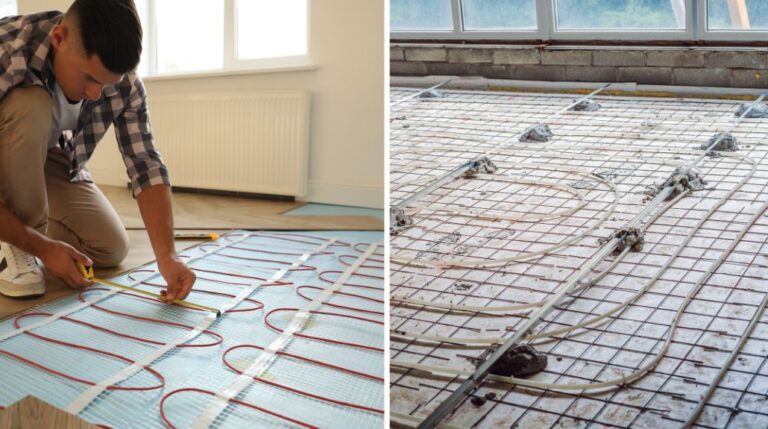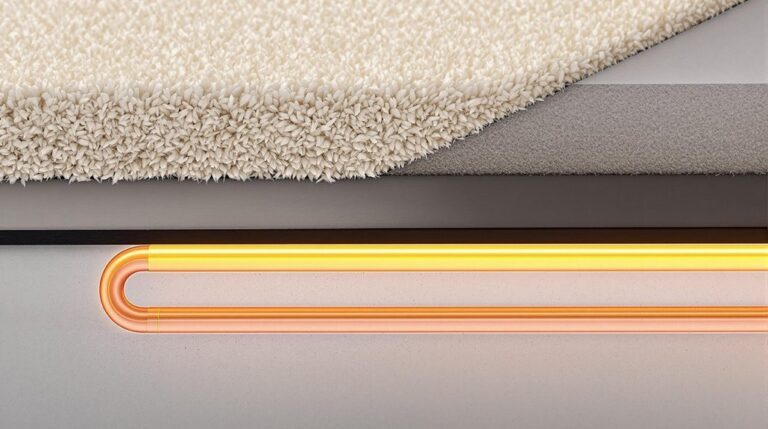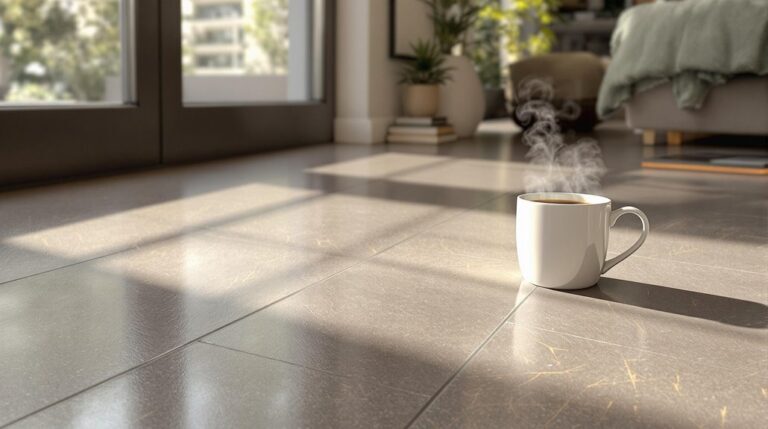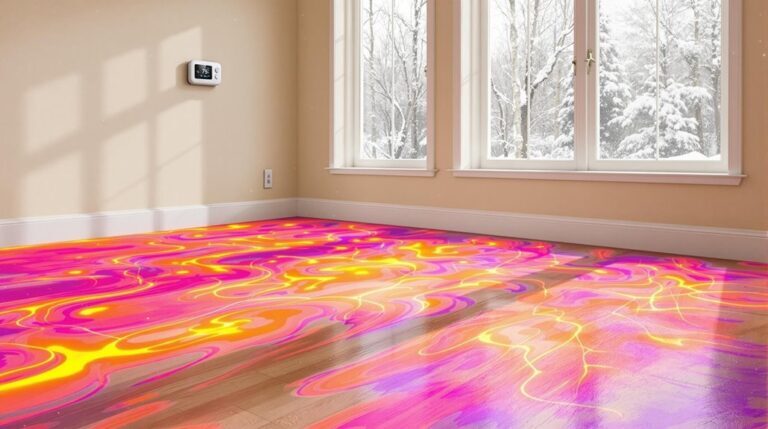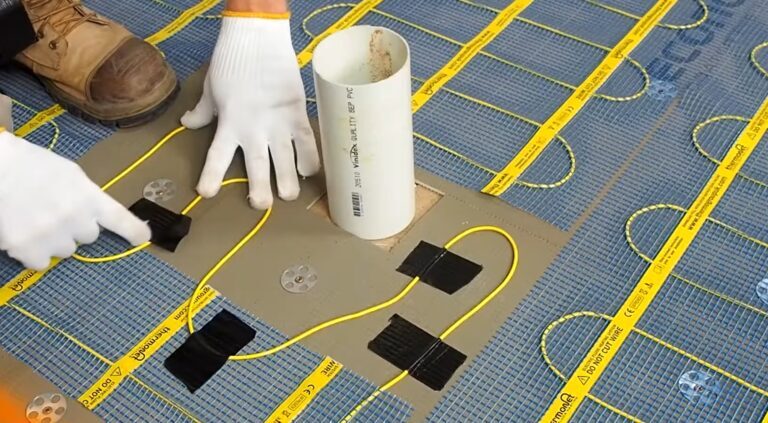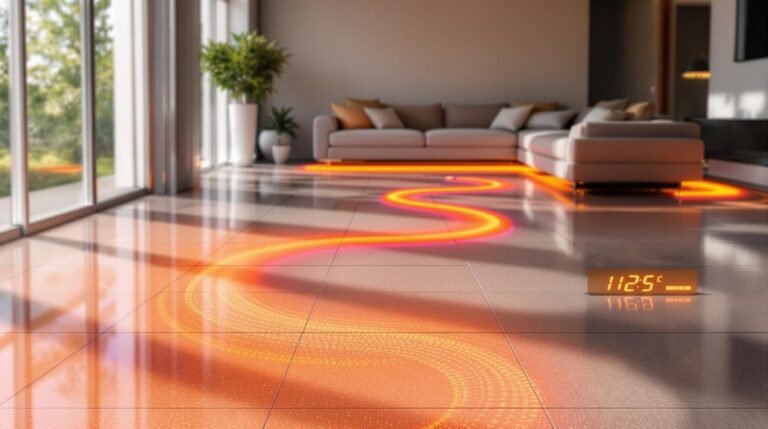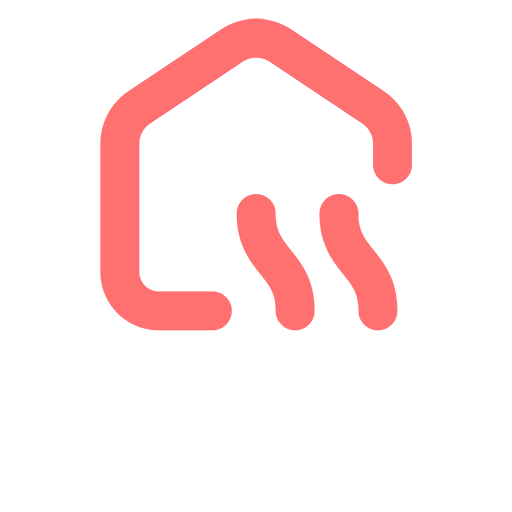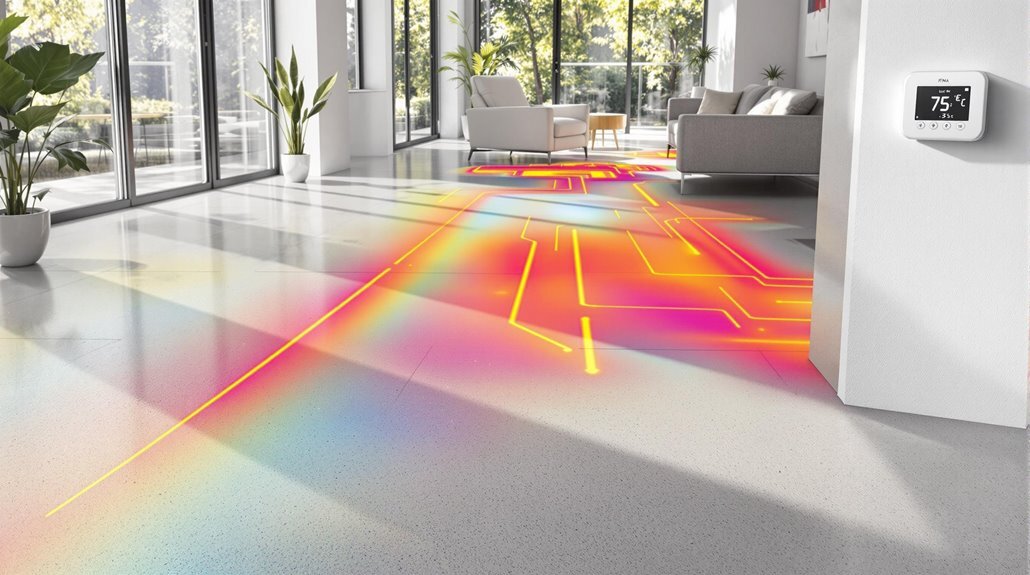
If you’re considering underfloor heating for your Australian home, you’ll find that costs can vary greatly based on your specific needs and circumstances. While a basic electric system might set you back $2,000, an extensive hydronic solution could exceed $7,000 for professional installation. These initial figures might seem intimidating, but they don’t tell the complete story of long-term value and comfort. Understanding the true cost involves examining several key factors, from installation methods to running expenses, that will ultimately determine whether this heating solution is right for your budget.
Key Takeaways
- Professional installation costs range from $2,000 to $7,000+, with an average of $100/m² for materials and labor in Australia.
- Electric in-slab systems start at $30/m², while hydronic in-slab systems cost about $70/m², excluding boiler costs.
- Monthly running costs vary between $20-$150, with daily operation costs around $1.12 for bedrooms and $4.20 for living rooms.
- Regular maintenance checks cost $200-$400 every two years, with common repairs ranging from $150-$300.
- New build installations are more cost-effective than renovation projects, which can reach $185/m² for custom designs.
Types of Underfloor Heating Systems – Electric Underfloor Heating & Hydronic Underfloor Heating
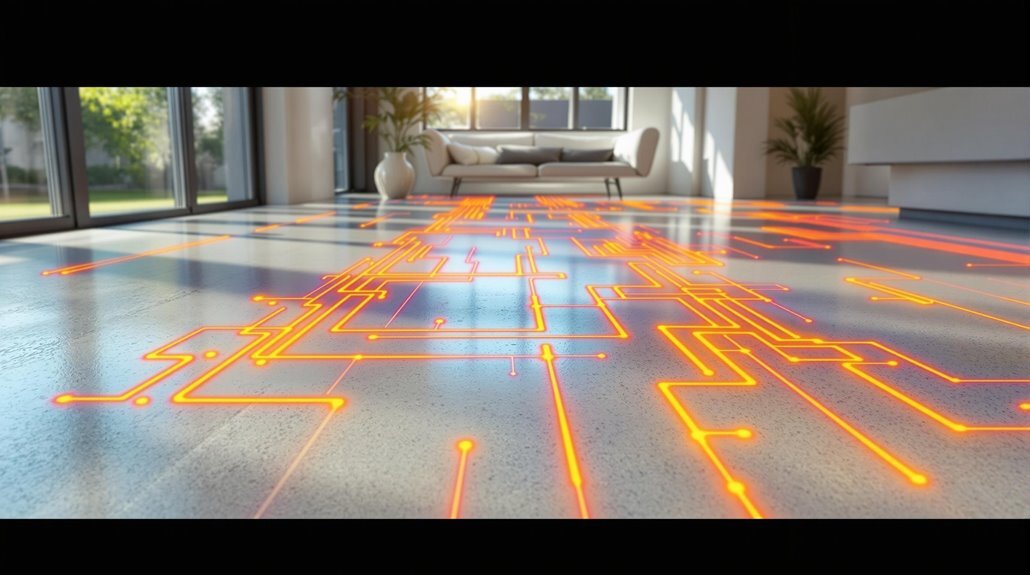
Flexibility in choosing the right underfloor heating system can make all the difference to your home’s comfort and energy efficiency. At Floor Heating Today, we’ve found that understanding the two main types of heating systems helps our Sydney customers make informed decisions about their investment.
Electric underfloor heating uses cables or heating mats installed beneath your floor surface, making it one of the popular heating options. It’s particularly effective for smaller spaces like bathrooms and kitchens, and you can control it precisely with a thermostat.
While the initial installation cost is typically lower than hydronic systems, you’ll need to factor in potential maintenance of the electrical cables over time and the overall cost to run.
Hydronic heating, on the other hand, operates by circulating hot water through a network of pipes under your floor. Though it requires a higher upfront investment, it often leads to lower running costs in the long term.
You can power these systems using various heat sources, including boilers, heat pumps, or solar panels, making them versatile for different energy preferences.
Both systems work effectively with suitable flooring types such as natural stone, ceramic tiles, laminate, and engineered timber.
If you’re considering carpet or solid timber, you’ll need specific system configurations to guarantee peak performance.
The installation cost varies depending on your location in Australia and the complexity of your project, with labour rates typically ranging from $120 to $170 per hour.
In-screed and in-slab installations require particular attention to detail and may influence your choice between electric and hydronic systems.
How Much Does Underfloor Heating Cost to Install
When planning your underfloor heating project, understanding the initial installation costs helps you budget effectively. In Australia, professional installation typically ranges from $2,000 to $7,000+, with costs averaging around $100 per square meter for both materials and labor.
Your choice between electric and hydronic systems greatly impacts the cost. Electric in-slab underfloor heating starts at $30 per square meter, while hydronic in-slab systems cost about $70 per square meter. For hydronic in-screed installations, you’re looking at $95 to $110 per square meter. Labor costs add another $25 to $30 per hour to your project.
The size of your area plays an essential role in determining costs. For example, a standard bathroom (3×2 meters) installation costs between $2,200 to $2,800, while a bedroom (3×3 meters) ranges from $2,400 to $3,200, both including thermostat installation.
If you’re installing during a new build, you’ll generally face lower costs compared to renovation projects. New build standard screed installations are more cost-effective, while renovation projects can reach up to $185 per square meter for custom designs, excluding installation fees for those looking to install underfloor heating.
Your total system cost will also depend on several additional factors, including the type of flooring material, insulation requirements, and the number of heating zones you need.
While electric systems typically have lower upfront costs, hydronic underfloor heating systems often provide more efficient heating for larger areas, affecting the overall cost to run. It’s worth getting multiple quotes to verify you’re getting competitive pricing for your specific installation needs.
Monthly Running Cost of Underfloor Heating
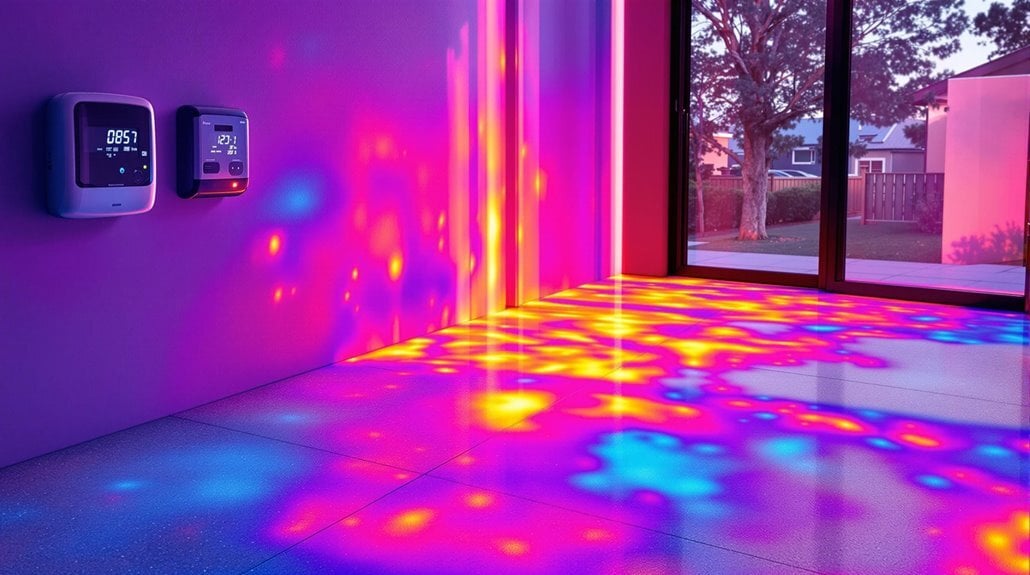
The predictability of monthly running costs helps homeowners better manage their budgets when considering underfloor heating. At Floor Heating Today, we’ve found that most Sydney homeowners can expect to pay between $20 to $150 per month for electric systems, with costs varying based on several key factors.
Your running costs primarily depend on your heated area size and insulation quality. Poor insulation leads to heat loss and higher electricity bills, while proper insulation can help you achieve the ideal heat load of 120 watts per square meter.
We’ve seen that underfloor heating systems are 20-50% more efficient than traditional heating methods when properly installed, reducing the heating running costs.
Modern thermostat technology plays an essential role in managing your costs. You can considerably reduce expenses by programming your system to heat only when needed and maintaining consistent temperatures.
The type of flooring material you choose also impacts efficiency – heated tile floors typically offer better heat distribution and lower running costs.
To keep your monthly expenses at the lower end of the range, we recommend:
- Installing quality insulation during the initial setup
- Using smart thermostats for precise temperature control
- Implementing effective heating schedules
- Conducting regular maintenance checks
While hydronic systems generally cost less to run than electric ones, your actual costs will vary based on your specific situation.
We’ve found that most Sydney homeowners can keep their monthly running costs between $25 to $100 with proper system management and regular maintenance needs addressed.
Cost Savings Over Time on Bills
Although the initial installation costs may seem substantial, underfloor heating delivers significant cost savings over time through reduced energy consumption and improved heating efficiency. When you invest in underfloor heating, you’ll notice immediate improvements in your home’s energy efficiency, with potential savings of up to 20% on your heating costs compared to traditional systems.
The cost savings become more apparent when you break down the daily running costs by room. You’ll spend approximately $1.12 per day for bedroom heating and $1.35 for bathroom heating, based on 4 hours of daily use. Even larger spaces like living rooms, running for 6 hours daily, cost around $4.20 – making it an economical choice for whole-home heating.
Here’s what makes underfloor heating a cost-effective long-term investment:
- Lower energy consumption due to even heat distribution and efficient temperature regulation
- Reduced maintenance costs compared to traditional heating systems
- Increased property value, making it a smart financial investment
- Elimination of radiators and heating units, saving valuable living space
- Smart thermostat compatibility for optimized energy usage and cost control
Your savings will compound over time as you benefit from reduced energy bills and improved heating efficiency. The installation cost is offset by these ongoing savings, making underfloor heating a financially sound choice for Australian homes.
Plus, you’ll enjoy the added benefits of improved air quality and reduced condensation, creating a more comfortable living environment while keeping your heating costs in check.
Floor Heating Repair and Maintenance Expenses
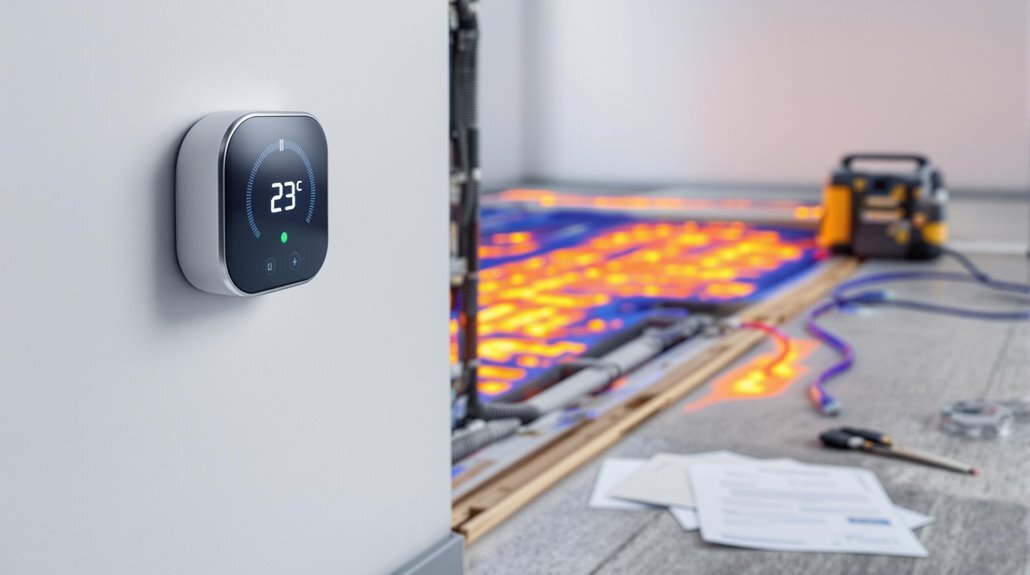
Most underfloor heating systems require minimal maintenance expenses, making them a cost-effective choice for Australian homeowners. The repair and maintenance costs primarily depend on how well you maintain your system and whether you address issues promptly.
To keep maintenance expenses low, you’ll need to perform regular checks of your underfloor heating system. We recommend inspecting your system annually, checking for any signs of wear, damage, or potential leaks. These simple checks can help prevent costly repairs down the line and maintain your system’s efficiency, keeping the underfloor heating cost to run at a minimum.
Professional servicing is essential every two years, costing between $200-$400 per service. During these visits, our technicians thoroughly inspect all components, clean the system, and address any developing issues. While this might seem like an additional expense, it’s considerably cheaper than dealing with major repairs caused by neglect.
The most common repair expenses come from fixing leaks or replacing damaged seals, which typically cost $300-$600 depending on the extent of the problem. However, you can minimize these costs by regularly checking seals and joints every few months. If you notice any issues, addressing them immediately will prevent higher energy bills and more expensive repairs.
You can also reduce maintenance costs by keeping your system clean. Regular vacuuming and wiping down the area around your heating system helps prevent dust buildup and maintains peak performance. This simple maintenance task costs nothing but can save you money by extending your system’s lifespan and preserving its efficiency.
Professional Underfloor Heating Installation Requirements
Professional installation of underfloor heating requires careful attention to Australian building codes and regulations to guarantee safety and peak performance. At Floor Heating Today, we ascertain all installations meet the strict requirements set by Australian Standard 2870, which includes increasing heated slab thickness by 25mm and upgrading reinforcing mesh specifications.
When considering professional installation, you’ll need to account for several key factors that influence both system performance and costs. Labour costs typically range from $120-$180 per hour, though this can vary by region and system complexity.
The installation process differs considerably between in-slab, in-screed, and electric systems, with each requiring specific expertise and adherence to regulations.
- All perimeter insulation must maintain an R-Value of 1.0 or higher and be water-resistant.
- Insulation must extend continuously from ground level to 300mm depth or full slab depth.
- Installation costs range from $30-$115 per square meter, depending on system type.
- In-slab systems average $68 per square meter (excluding boiler costs).
- In-screed systems cost between $105-$230 per square meter (excluding boiler costs).
Whether you’re retrofitting an existing space or installing during new construction, professional installation ascertains your heating system meets all necessary regulations.
The type of flooring material, system complexity, and your home’s specific requirements will determine the final installation approach. Our team carefully assesses these factors to deliver a heating solution that’s both compliant and efficient.
Market Trends and Future Pricing
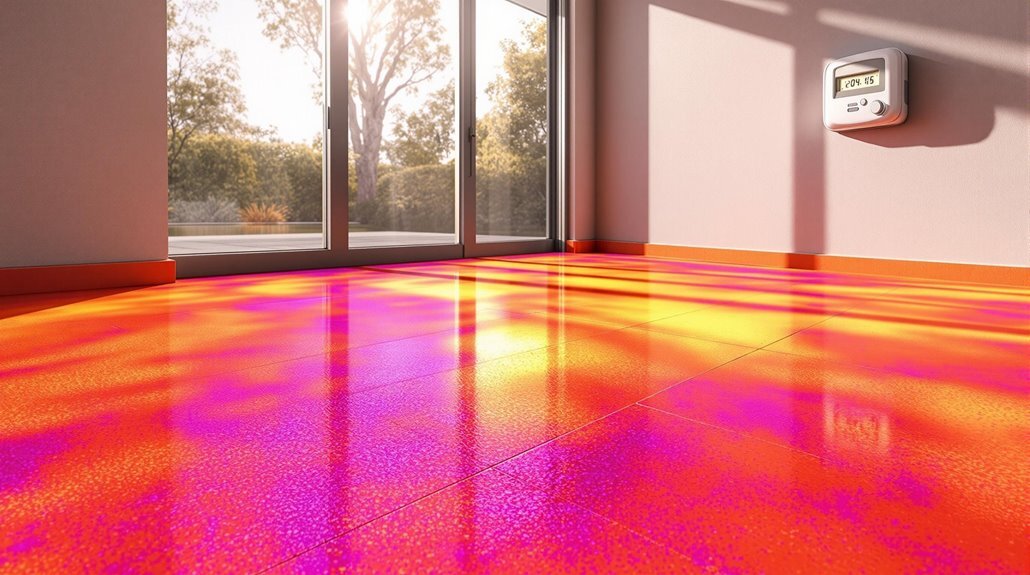
Recent market analysis reveals a steady increase in underfloor heating adoption across Australia, with installation costs ranging from $30 to $115 per square meter. At Floor Heating Today, we’ve observed that this growth is primarily driven by homeowners’ increasing focus on energy efficiency and the integration of smart heating technologies. Smart technology is a major thing to consider with technological advancements rapidly changing.
You’ll find that electric heating systems currently cost around $40 per square meter for in-slab installations, while hydronic heating systems average $70 per square meter. These installation costs are influenced by factors like system type, room size, and floor construction.
Despite higher upfront costs, you can expect to save 20-50% on your energy bills compared to traditional heating methods.
Looking ahead to 2025, we’re seeing several trends that will impact pricing. The integration of renewable energy sources with underfloor heating systems is becoming more common, potentially reducing long-term running costs.
However, market challenges like high installation costs and retrofitting difficulties continue to affect pricing structures.
For your budgeting purposes, it’s worth noting that complete system installations typically range from $2,000 to $7,000+, depending on your home’s size. While these costs might seem significant, the minimal maintenance requirements and improved energy efficiency make underfloor heating an increasingly attractive investment.
We’re also seeing technological advancements in thermostatic controls and heating elements, which should help optimize both installation and running costs in the coming years.


